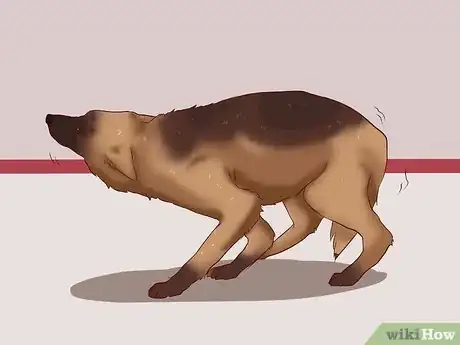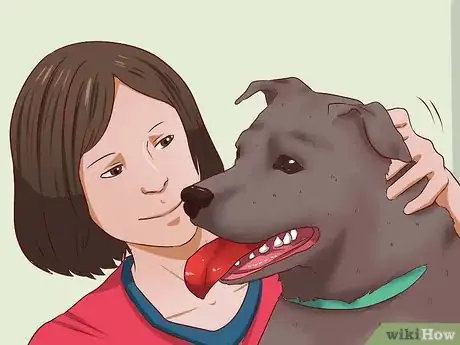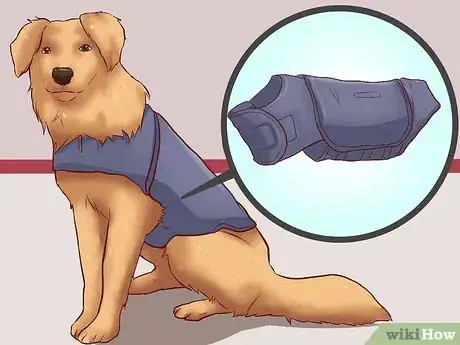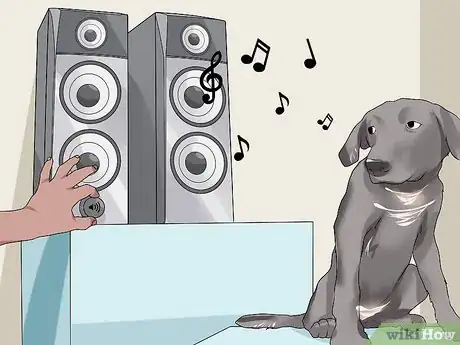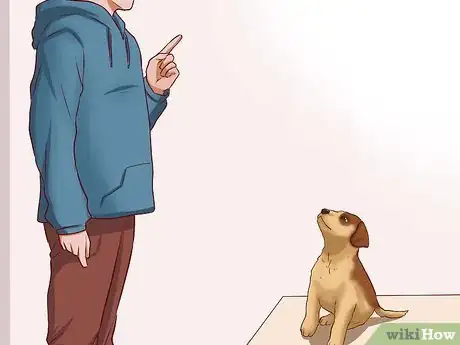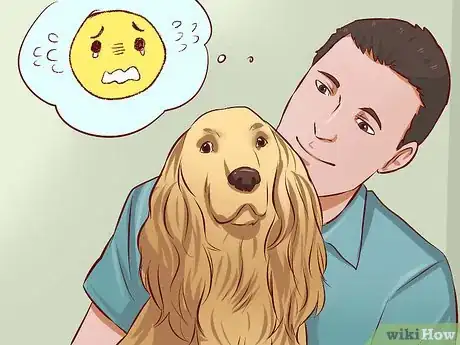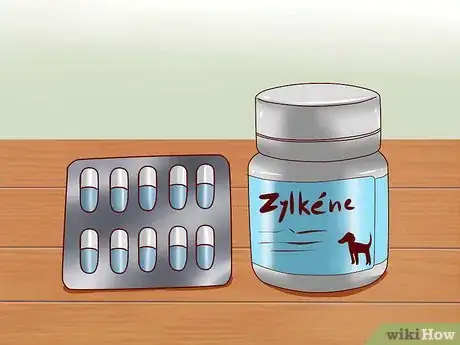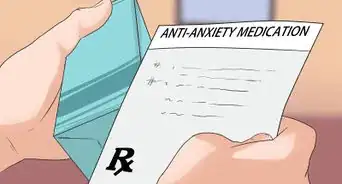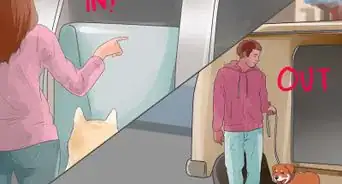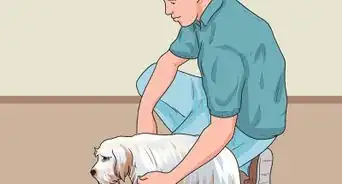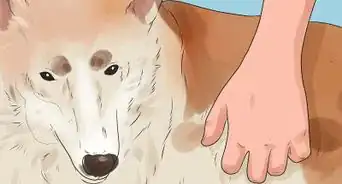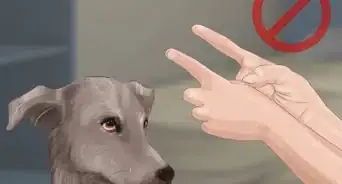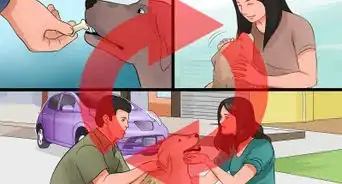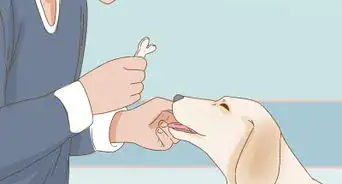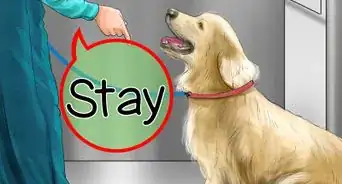This article was co-authored by Jaimie Scott. Jaimie Scott has been training dog owners as the Owner of Jaimie Scott Dog Training in Sacramento, California for the past 15 years. Jaimie meets clients for 1-on-1 training, group classes (owners only, no dogs), as well as live video classes. Jaimie has published videos, blog articles, and eBooks to share tips for training and his personalized insight into dog behavior. With a focus on training the owners, Jaimie believes that dogs need to know who’s in control at any given time in order to feel secure and be happy. Jaimie holds a BS in Mathematics and Computer Science from Pacific University.
There are 13 references cited in this article, which can be found at the bottom of the page.
This article has been viewed 351,315 times.
Ultimately, how you decide to calm your dog will depend on the situation. Strangers, thunder claps, firework booms, garbage trucks, trips to the veterinarian, and other animals can cause your dog to become scared, anxious, or excitable. Our instinct is to coddle and to hug, but there are better ways to handle the situation — ones that will teach your dog not to be afraid, anxious, or excitable. In order to calm a dog, you’ll need to interpret your dog’s behavior and take the time to understand what is causing your dog’s reaction.
Steps
Calming Your Dog
-
1Recognize the body language of an anxious dog. Dog body language is complex and can often be misread.There is no universal sign of anxiety or fear to look for because every dog reacts differently.It is not unusual for one fearful dog to act aggressive and another to run away and hide. Both dogs want to be safe, but they process the situation differently.
Signs of Anxiety in a Dog
- Hunched body posture
- Averted gaze/dilated pupils
- Ears held down or slightly backwards
- Furrowed brow
- Whining
- Shaking/shivering
- Sweaty paws
- Loss of bladder or bowel control[1] -
2Understand the cause of your dog’s behavior. Most of the time, this will be obvious. Your dog is clearly afraid of thunder, a specific person, a loud sound, or a particular space.Put yourself in your dog’s place.You know little of the world, but you see something formidable. How would you react? Have empathy for your friend.[2]Advertisement
-
3Minimize the source of anxiety. Take your dog into another room if a particular person is making it anxious. Close the blinds and turn up the music to mask the sound of thunder or fireworks. If your dog wants to turn tail and hide in its safe space, perhaps its crate, cover it with a light blanket, to help muffle the frightening sound. Again,the method you choose to employ to calm your dog all depends on what it is afraid of.[3]
- You can create a safe space for your dog, by opening a door to a room away from the loud sounds or your can crate train it. In the latter case, your dog will come to find its crate to be the most comforting place of all.[4]
-
4Distract your dog.[5] You want to give your dog something else to focus on — something “positive” and even productive. Does your dog have a favorite toy or chew stick? If so, present your dog with it to distract it from the negative stimuli.Turn a stressful situation into a playful one.Eventually, your dog will associate whatever is causing them stress initially with a fun experience and then later on they won’t be so affected by the negative stimuli (i.e. strangers, thunder, the vet, or other animals).
-
5Pet your dog. Every dog is different. Every dog enjoys different types of petting. Some like soft gentle strokes, while others like hardy pats and squeezes. One of the most common petting strategies is thegentle sweep of the back.Place the palm of your hand on the top of your dog's head and slowly follow your dog's spine to its hips. Do this repeatedly in order to calm your dog.[6]
- However, be aware that petting your dog can be misread by the dog as being rewarded for feeling fearful. Counterintuitive as it sounds, petting the dog can inadvertently train him to be fearful in future. Judge the situation, but sometimes it is much better to ignore his fearful behavior which sends the message that there's nothing to worry about.
-
6
-
7Play classical music to your dog. Many dog owners and animal shelters quietly play classical music to soothe the dogs.
Preventing Your Dog’s Anxiety
-
1Train your dog.[9] Many dog trainers believe that excessively anxious, excitable, or frightened dogs are thedirect result of insufficient training.You must reinforce positive behavior when training your dog. Teach it to not get anxious at the vet, excitable at the dog park, or frightened by thunderstorms. Do this by offering an alternative task to focus on and then rewarding it when it completes the task successfully.[10]
Training a Dog Example
During a trip to the veterinarian’s office, if you dog gets overly anxious in the waiting room, tell it to “sit” or “lay down”. Really any basic command will do. Then reward your dog after they’ve successfully followed your command.
This will reinforce the training and take your dog’s mind off of the stressful situation. In the future, your dog may even associate the waiting room of the vet with sitting and receiving a treat, not with being probed by a stranger.[11] -
2Mask your own reaction. Your dog thinks of you as a member of its pack. If he sees you anxious or fearful, he will adopt a similar emotional state. If you find yourself in an unsettling situation, don’t let it show. Take deep breaths and count them, exhaling slowly and deliberately.
Examples of Masking Your Reactions
If you take your pet to the vet for an operation and you’re stressed about it, don’t let your dog see it. You want to always create a positive experience for your dog in these situations.Don’t shriek every time you hear a thunder clap, because your dog will think there is something to fear. This will cause anxiety too.[12]
-
3Use pheromone diffusers. Pheromones are chemical messengers given off by a dog’s mother during nursing to reassure her pups that they are safe and secure. Synthetic versions of this chemical, known asDog Appeasing Pheromones (DAPs)are available for purchase as many pet superstores. Simply plug them into the wall or attach them to your dog’s collar and watch them calm your canine companion.[13]
-
4Give your dog a zylkene supplement. Zylkene contains a protein extracted from milk that acts as a calming agent — like diazepam. This capsule is given twice daily and has been shown to calm dogs during thunderstorms, trips to the vet, or stays at the kennel.[14]
-
5Talk to your veterinarian. They will be able to advise you on what measures will work best - either behavioral or medical. If necessary, you can get a prescription for stronger medications.Only give these to your dogs if your vet prescribes themand do so according to the vet's instructions. Four types of medicines are usually used to treat behavior problems in dogs. These are benzodiazepines (BZs), monoamine oxidase inhibitors (MAOIs), tricyclic antidepressants (TCAs) and selective serotonin reuptake inhibitors (SSRIs).[15]
Expert Q&A
Did you know you can get expert answers for this article?
Unlock expert answers by supporting wikiHow
-
QuestionHow do I calm my dog down?
 Jaimie ScottJaimie Scott has been training dog owners as the Owner of Jaimie Scott Dog Training in Sacramento, California for the past 15 years. Jaimie meets clients for 1-on-1 training, group classes (owners only, no dogs), as well as live video classes. Jaimie has published videos, blog articles, and eBooks to share tips for training and his personalized insight into dog behavior. With a focus on training the owners, Jaimie believes that dogs need to know who’s in control at any given time in order to feel secure and be happy. Jaimie holds a BS in Mathematics and Computer Science from Pacific University.
Jaimie ScottJaimie Scott has been training dog owners as the Owner of Jaimie Scott Dog Training in Sacramento, California for the past 15 years. Jaimie meets clients for 1-on-1 training, group classes (owners only, no dogs), as well as live video classes. Jaimie has published videos, blog articles, and eBooks to share tips for training and his personalized insight into dog behavior. With a focus on training the owners, Jaimie believes that dogs need to know who’s in control at any given time in order to feel secure and be happy. Jaimie holds a BS in Mathematics and Computer Science from Pacific University.
Dog Owner Trainer The best response is to remove the dog from the situation as soon as possible and let him calm down on his own. Trying to train your dog while he's excited will only reinforce that behavior. Besides training, make sure your dog gets enough exercise, playtime, and chew time each day. Dogs that have an outlet for their energy are less likely to get excited and anxious.
The best response is to remove the dog from the situation as soon as possible and let him calm down on his own. Trying to train your dog while he's excited will only reinforce that behavior. Besides training, make sure your dog gets enough exercise, playtime, and chew time each day. Dogs that have an outlet for their energy are less likely to get excited and anxious. -
QuestionMy energetic 8 month dog is obedient to me but not my wife, and he even disobeys me when she is around. What can we do?
 Pippa Elliott, MRCVSDr. Elliott, BVMS, MRCVS is a veterinarian with over 30 years of experience in veterinary surgery and companion animal practice. She graduated from the University of Glasgow in 1987 with a degree in veterinary medicine and surgery. She has worked at the same animal clinic in her hometown for over 20 years.
Pippa Elliott, MRCVSDr. Elliott, BVMS, MRCVS is a veterinarian with over 30 years of experience in veterinary surgery and companion animal practice. She graduated from the University of Glasgow in 1987 with a degree in veterinary medicine and surgery. She has worked at the same animal clinic in her hometown for over 20 years.
Veterinarian Consistency is key to good dog training, which means all members of the family must train the dog, react in the same way to bad behavior, and use the same commands. Beef up your dog's basic training by working on a rock solid, "Sit" and "Come" to control the dog when at home. Explain to your wife the importance of becoming involved in the dog's training. Write down a list of basic commands and their cue words and display it on the fridge. Show your wife how to get the dog to perform the desired action.
Consistency is key to good dog training, which means all members of the family must train the dog, react in the same way to bad behavior, and use the same commands. Beef up your dog's basic training by working on a rock solid, "Sit" and "Come" to control the dog when at home. Explain to your wife the importance of becoming involved in the dog's training. Write down a list of basic commands and their cue words and display it on the fridge. Show your wife how to get the dog to perform the desired action. -
QuestionHow do I get a dog to stop chasing things?
 Pippa Elliott, MRCVSDr. Elliott, BVMS, MRCVS is a veterinarian with over 30 years of experience in veterinary surgery and companion animal practice. She graduated from the University of Glasgow in 1987 with a degree in veterinary medicine and surgery. She has worked at the same animal clinic in her hometown for over 20 years.
Pippa Elliott, MRCVSDr. Elliott, BVMS, MRCVS is a veterinarian with over 30 years of experience in veterinary surgery and companion animal practice. She graduated from the University of Glasgow in 1987 with a degree in veterinary medicine and surgery. She has worked at the same animal clinic in her hometown for over 20 years.
Veterinarian Movement is a strong trigger for the natural chasing instinct, so whilst you are training the dog, keep him on a long line. This enables you to give a command, and if it is not obeyed repeat the command and reel the dog in. Meantime, work on basic training so the dog listens to you, and teach commands such as "Sit" and "Look" which focus the dog's attention on you and stop him getting distracted by the moving object.
Movement is a strong trigger for the natural chasing instinct, so whilst you are training the dog, keep him on a long line. This enables you to give a command, and if it is not obeyed repeat the command and reel the dog in. Meantime, work on basic training so the dog listens to you, and teach commands such as "Sit" and "Look" which focus the dog's attention on you and stop him getting distracted by the moving object.
References
- ↑ Canine Behavior: A Guide for Veterinarians. Bonnie Beaver. Publisher: Saunders
- ↑ Canine Behavior: A Guide for Veterinarians. Bonnie Beaver. Publisher: Saunders
- ↑ The Happy Puppy Handbook. Pippa Mattinson. Publisher: Ebury Press.
- ↑ http://www.brown.edu/Research/Colwill_Lab/CBP/Crate.htm
- ↑ Jaimie Scott. Dog Owner Trainer. Expert Interview. 16 June 2020.
- ↑ http://moderndogmagazine.com/articles/how-massage-your-dog/2028
- ↑ http://www.thundershirt.com
- ↑ The Happy Puppy Handbook. Pippa Mattinson. Publisher: Ebury Pre
- ↑ Jaimie Scott. Dog Owner Trainer. Expert Interview. 16 June 2020.
- ↑ In Defence of Dogs. John Bradshaw. Publisher: Penguin
- ↑ http://www.veterinarypartner.com/Content.plx?A=1574
- ↑ In Defence of Dogs. John Bradshaw. Publisher: Penguin
- ↑ Canine Behavior: A Guide for Veterinarians. Bonnie Beaver. Publisher: Saunder
- ↑ Canine Behavior: A Guide for Veterinarians. Bonnie Beaver. Publisher: Saunders
- ↑ https://www.aspca.org/pet-care/virtual-pet-behaviorist/dog-behavior/behavioral-medications-dogs
- ↑ Jaimie Scott. Dog Owner Trainer. Expert Interview. 16 June 2020.
- ↑ https://www.aspca.org/pet-care/virtual-pet-behaviorist/dog-behavior/how-will-spaying-change-my-dog
- www.psychologytoday.com/blog/canine-corner/201604/the-data-says-dont-hug-the-dog
About This Article
If your dog is agitated and you want to calm it down, take steps to minimize the cause of anxiety, such as by turning up music to mask the sound of fireworks. Alternatively, try distracting your dog by giving it a chew stick or its favorite toy. If your dog likes to be petted, gently stroke or pat its back to help it calm down. Another option you could consider to deal with your dog's fear is to use a thundershirt, which applies pressure around the dog's torso and is found by some dogs to be soothing. For tips on how to manage your dog's anxiety, including why it's important to train them well, read on!
